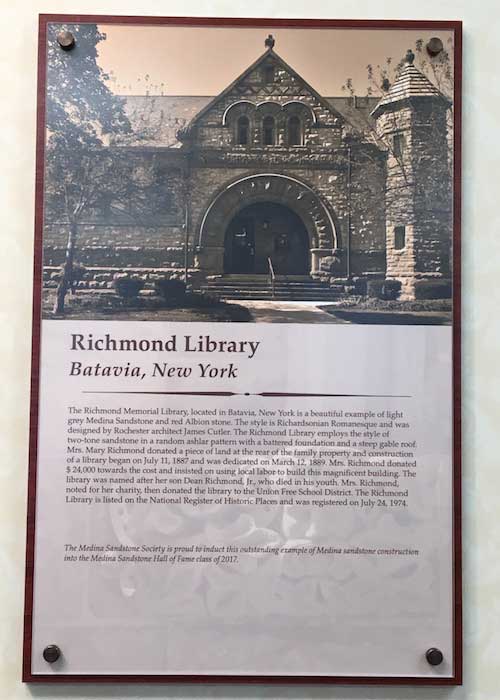4 sites inducted into Medina Sandstone Hall of Fame
Presbyterian Church in Albion, Batavia library, Rochester cemetery and Jamestown church join exclusive club
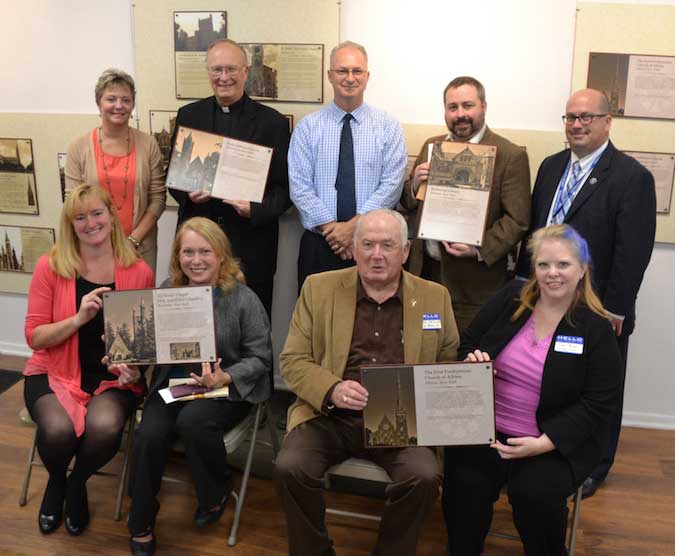
Photo by Tom Rivers: Four new inductees were added to the Medina Sandstone Hall of Fame this afternoon, including First Presbyterian Church in Albion, Holy Sepulchre Cemetery in Rochester, Richmond Memorial Library in Batavia, and First Lutheran Church of Jamestown. Pictured in front from left: Cathy Vail, CFO for Holy Sepulchre; Lynn Sullivan, CEO of Holy Sepulcre; Tim McGee, elder at First Presbyterian Church in Albion; and Twyla Boyer, First Presbyterian’s pastor. Back row: Brenda Gagliano, Holy Sepulchre’s records coordinator; Dan Nagle, pastor of First Lutheran Church in Jamestown; Jim Jacobs, facilities director for Batavia City School District which owns and maintains Richmond Memorial Library in Batavia; Rob Conrad, director of Richmond Memorial; and Chris Dailey, superintendent of Batavia City School District.
MEDINA – The Medina Sandstone Hall of Fame inducted four new members into the Medina Sandstone Hall of Fame, bringing the number of inductees in the HOF to 24 since the first class was inducted in 2013.
The new inductees include the First Presbyterian Church in Albion, Holy Sepulchre Cemetery in Rochester, Richmond Memorial Library in Batavia, and First Lutheran Church of Jamestown.
The Presbyterian Church is the ninth site from Orleans County in the Hall of Fame. Genesee has its first entry with the library in Batavia. Jamestown and Chautauqua County are also making their debut in the Medina Sandstone Hall of Fame with the First Lutheran Church. Holy Sepulchre is second site from Rochester to join the HOF.
The Hall of Fame Committee – Jim Hancock, David Miller and Don Colquhoun – make road trips to all of the nominees and do research on the buildings. Hancock, the Sandstone Society president, said he has developed a far deeper appreciation for the local quarried stone.
“We have been truly amazed over the years of the multitude of buildings that are still standing from a seemingly indestructible building material,” Hancock.
The Hall of Fame inductees all deserve praise for maintaining what are often cavernous structures, Hancock said. All of the inductees today shared stories of recent costly renovations, from mortar repointings to new slate roofs.
The following were inducted in the Class of 2016, with the descriptions courtesy of Medina Sandstone Society:
• First Presbyterian Church of Albion

Jim Hancock, right, reads the plaque about the First Presbyterian Church in Albion, which was represented by elder Tim McGee and pastor Twyla Boyer.
The First Presbyterian Church is a beautiful example of rose colored Medina Sandstone. The church commissioned famed architect Andrew Jackson Warner from Rochester to come up with a design for the new church.
It is rumored that the building committee told the architect they wanted a building like his First Presbyterian Church he built in 1871 in Rochester, but with a steeple taller than the Albion Baptist Church. The steeple was to be 175 feet, taller by 15 feet. Construction began in 1874 and completed and dedicated in 1875 and for over 140 years the bells in the majestic bell tower have been calling worshipers to service every Sunday.
***
Boyer spoke during the Hall of Fame induction at Medina City Hall, where the plaques are on display. She said the Albion congregation has been a dedicated steward of the building.
“It is a beautiful church,” she said. “It is a pleasure to be there.”
McGee said the congregation has tackled a recent major interior renovation and last year had to fix the slate roof.
“We continue to make progress preserving the church,” he said. “It’s just beautiful inside.”
• Richmond Memorial Library in Batavia
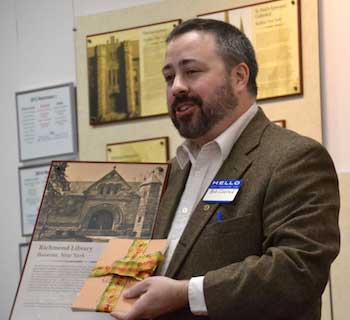
Rob Conrad, the library director, praised the Batavia City School District for its ongoing maintenance of the historic site.
The Richmond Memorial Library is a beautiful example of light gray Medina Sandstone and red Albion stone. The style is Richardsonian Romanesque and was designed by Rochester architect James Cutler. The Richmond Library employs the style of two-tone sandstone in a random ashlar pattern with a battered foundation and a steep gable roof.
Mrs. Mary Richmond donated a piece of land at the rear of the family property and construction of a library began on July 11, 1887 and was dedicated on March 12, 1889. Mrs. Richmond donated $24,000 towards the cost and insisted on using local labor to build this magnificent building.
The library was named after her son Dean Richmond, Jr., who died in his youth. Mrs. Richmond, noted for her charity, then donated the library to the Union Free School District. The Richmond Library is listed on the National Register of Historic Places and was registered on July 24, 1974.
***
Rob Conrad, library director, said he and the staff are thrilled to see the library go into the Hall of Fame. He praised the Batavia City School District for its ongoing commitment to maintain the site. Conrad said he is impressed by the communities that rallied their dollars to build such impressive buildings in the region, using Medina Sandstone.
“You see the beauty of the buildings and their ingenuity,” he said.
• Holy Sepulchre Cemetery in Rochester
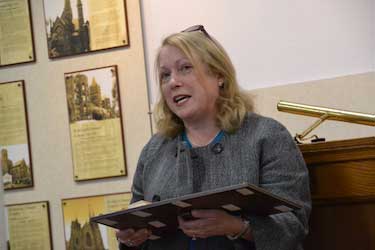
Lynn Sullivan, CEO of Holy Sepulchre, accepts the award for cemetery.
All Souls’ Chapel, designed by noted architect Andrew Jackson Warner, was built in 1876, and has become the centerpiece of the Holy Sepulchre Cemetery in Rochester, N.Y. The small but graceful building features a steep slate roof, supporting hammer beams, and exquisitely designed stained glass windows featuring the 14 stations of the Cross made in Roermond, Holland.
A companion 100-foot bell tower built in 1886 houses a six crypt mausoleum, the final resting place for the Bishops of the diocese including Bishop Bernard McQuaid, the founder of the cemetery. The Chapel as well as the two gate houses and 1.36-mile stone wall surrounding the cemetery are all made of beautifully preserved and restored red Medina Sandstone.
***
Holy Sepulchre is “synonymous with Medina Sandstone,” said Lynn Sullivan, the cemetery’s chief executive officer. The cemetery is committed to keeping up the historic chapel and bell tower.
“We love Medina Sandstone,” she said. “It’s what the cemetery is known for.”
• First Lutheran Church in Jamestown
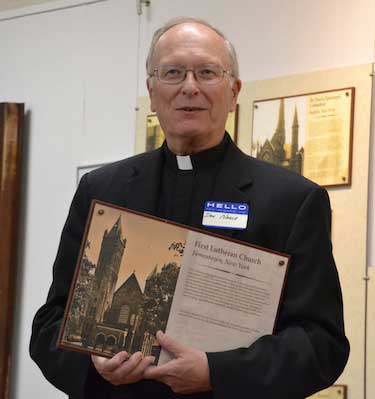
The Rev. Dan Nagle is proud of the church in Jamestown, which has 1,100 seats and spectacular stained-glass windows.
First Lutheran congregation was organized by Swedish immigrants in 1856. The construction of their present beautiful cathedral made entirely of red Medina sandstone was started in 1892 and completed in 1901.
It is a magnificent structure and includes a 153-foot-tall bell tower which still functions today. The congregation takes great pride in maintaining the beauty of the church which dominates the city’s skyline.
Many internal and external improvements and restorations have occurred over the years. The interior includes a historic 1901 Hook and Hastings pipe organ rebuilt in 1955, two tiered seating, and numerous beautifully detailed stained glass windows.
***
The Swedish immigrants who founded the church mortgaged their homes ensure the construction would move forward at the church, the Rev. Dan Nagle said.
He leads the church today and remains humbled by the sacrifice and vision of the congregation in the 1890s.
For more on the Medina Sandstone Hall of Fame, click here. (The plaques were are made and donated by Takeform Architectural Graphics in Medina.)


















